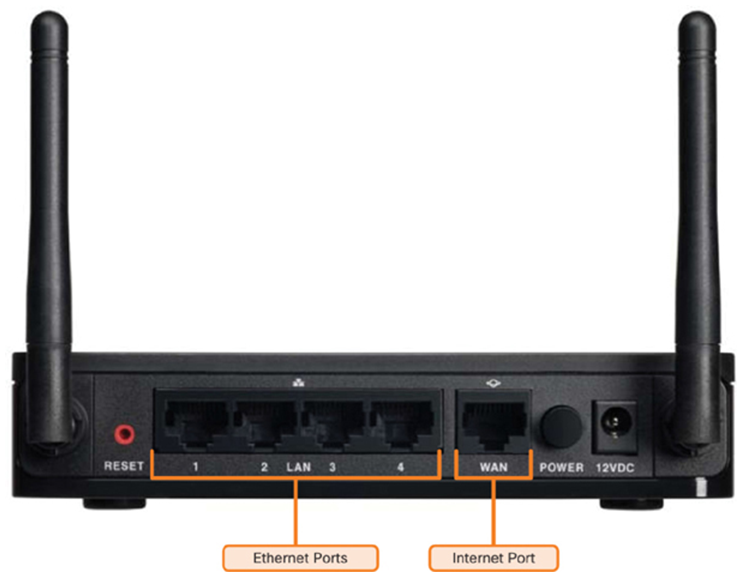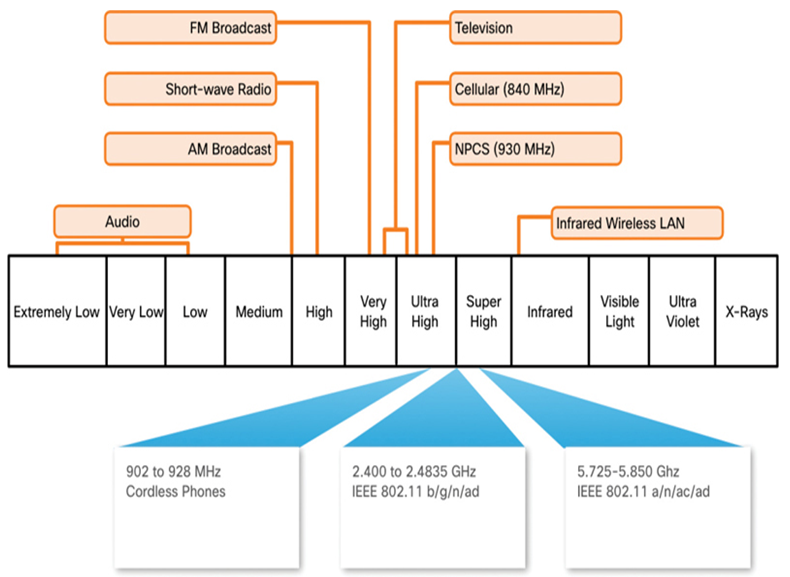Small business and home routers typically have two primary types of ports:
• Ethernet Ports —These ports connect to the internal switch portion of the router. These ports are usually labeled “Ethernet” or “LAN”, as shown in Figure 4-2. All devices connected to the switch ports are on the same local network.
• Internet Port — This port is used to connect the device to another network. The internet port connects the router to a different network than the Ethernet ports. This port is often used to connect to the cable or DSL modem in order to access the internet.
In addition to the wired ports, many home routers include a radio antenna and a built-in wireless access point. By default, the wireless devices are on the same local network as the devices that are physically plugged into the LAN switch ports. The internet port is the only port that is on a different network in the default configuration.

Figure 4-2 Back Panel of a Home Wireless Router
Network Technologies in the Home (4.2)
What would we do without wireless? Because of the ever-increasing number of things that have the capability of connecting to the internet using wireless technologies, most home networks include some type of wireless network functionality.
LAN Wireless Frequencies (4.2.1)
The wireless technologies most frequently used in home networks are in the unlicensed 2.4 GHz and 5 GHz frequency ranges.
Bluetooth is a technology that makes use of the 2.4 GHz band. It is limited to low-speed, short-range communications, but has the advantage of communicating with many devices at the same time. This one-to-many communication has made Bluetooth technology the preferred method for connecting computer peripherals such as wireless mice, keyboards and printers. Bluetooth is a good method for transmitting audio to speakers or headphones.
Other technologies that use the 2.4 GHz and 5 GHz bands are the modern wireless LAN (WLAN) technologies that conform to the various IEEE 802.11 standards. Unlike Bluetooth technology, 802.11 devices transmit at a much higher power level giving them a great range and improved throughput. Certain areas of the electromagnetic spectrum can be used without a permit.
Figure 4-3 shows where wireless technologies exist on the electromagnetic spectrum.

Figure 4-3 Electromagnetic Spectrum
Wired Network Technologies (4.2.2)
Although many home network devices support wireless communications, there are still a few applications where devices benefit from a wired switch connection that is not shared with other users on the network.
The most commonly implemented wired protocol is the Ethernet protocol. Ethernet uses a suite of protocols that allow network devices to communicate over a wired LAN connection. An Ethernet LAN can connect devices using many different types of wiring media.
Directly connected devices use an Ethernet patch cable, usually unshielded twisted pair. These cables can be purchased with the RJ-45 connectors already installed, and they come in various lengths. Recently constructed homes may have Ethernet jacks already wired in the walls of the home. For those homes that do not have UTP wiring, there are other technologies, such as powerline, that can distribute wired connectivity throughout the premises.
